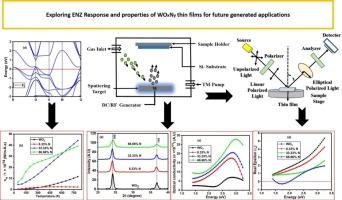探索氮化钨的epsilon近零响应和增强特性:DFT和实验研究
IF 4.6
3区 材料科学
Q2 MATERIALS SCIENCE, MULTIDISCIPLINARY
引用次数: 0
摘要
本研究主要研究了氮掺杂对WO3光电子材料结构、电子、光学和热电性能的影响。采用密度泛函理论和实验方法对磁控溅射制备的薄膜进行了分析。氮的掺入减小了带隙,诱导了直接跃迁,增强了电荷迁移率。态谱密度证实了较强的p-d杂化,其中W-d和O-p轨道起关键作用。热电分析表明,在恒定松弛时间近似下,使用BoltzTraP计算得到的电导率从未掺杂WO3的0.93 × 1019 (S/m·S)显著增加到氮含量最高的组分的46 × 1019 (S/m·S)。然而,过量的掺杂增加了热传导率和声子散射,降低了热电效率。x射线衍射分析显示了立方相,而光学分析记录了折射率和吸收系数的显著变化,以及在近红外可见范围内出现的epsilon近零行为,这凸显了其在先进光电应用中的潜力。本文章由计算机程序翻译,如有差异,请以英文原文为准。

Exploring epsilon near zero response and enhanced properties in tungsten Oxynitride: A DFT and experimental study
The current study investigated the effects of nitrogen doping on the structural, electronic, optical, and thermoelectric properties of WO3 for optoelectronic applications. The analysis was conducted using both density functional theory and experimental studies on thin films synthesized via magnetron sputtering. Nitrogen incorporation reduced the band gap, induced a direct transition, and enhanced charge mobility. The density of state spectra confirmed strong p-d hybridization, with W-d and O-p orbitals playing a key role. Thermoelectric analysis showed a significant increase in electrical conductivity from 0.93 × 1019 (S/m·s) in undoped WO3 to 46 × 1019 (S/m·s) in composition having maximum nitrogen content, as calculated using BoltzTraP under constant relaxation time approximation. However, excessive doping increased thermal conductivity and phonon scattering, reducing thermoelectric efficiency. X-ray diffraction analysis revealed the cubic phase, while optical analysis recorded notable changes in the refractive index and absorption coefficient, along with the emergence of epsilon-near-zero behavior in the NIR-visible range, which highlights its potential for advanced optoelectronic applications.
求助全文
通过发布文献求助,成功后即可免费获取论文全文。
去求助
来源期刊

Materials Science and Engineering: B
工程技术-材料科学:综合
CiteScore
5.60
自引率
2.80%
发文量
481
审稿时长
3.5 months
期刊介绍:
The journal provides an international medium for the publication of theoretical and experimental studies and reviews related to the electronic, electrochemical, ionic, magnetic, optical, and biosensing properties of solid state materials in bulk, thin film and particulate forms. Papers dealing with synthesis, processing, characterization, structure, physical properties and computational aspects of nano-crystalline, crystalline, amorphous and glassy forms of ceramics, semiconductors, layered insertion compounds, low-dimensional compounds and systems, fast-ion conductors, polymers and dielectrics are viewed as suitable for publication. Articles focused on nano-structured aspects of these advanced solid-state materials will also be considered suitable.
 求助内容:
求助内容: 应助结果提醒方式:
应助结果提醒方式:


